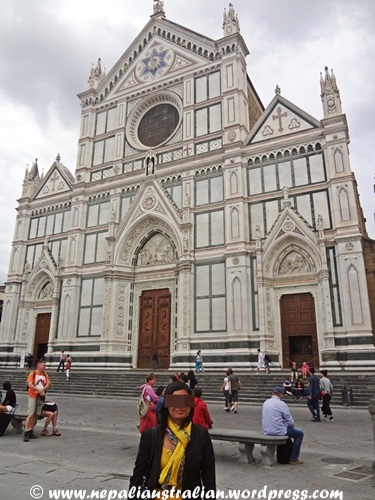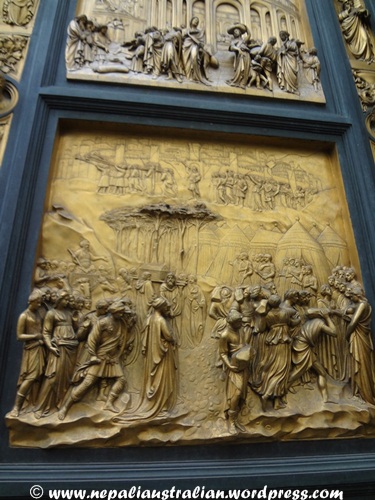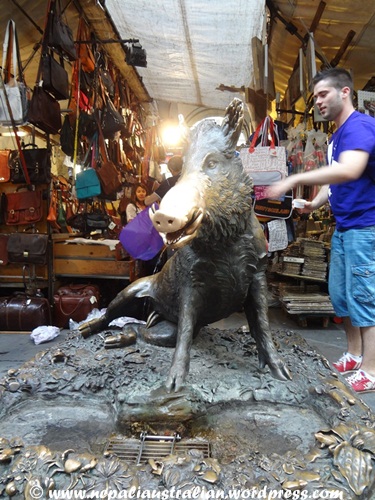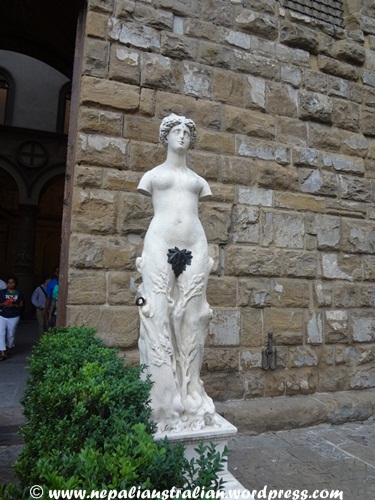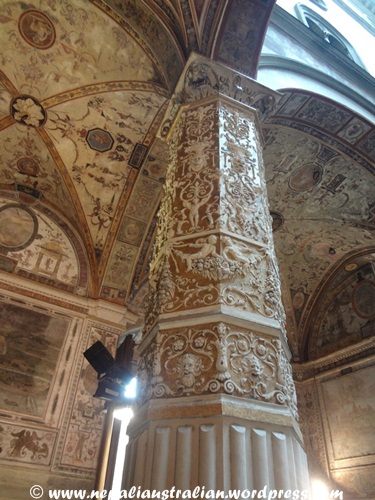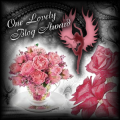Tuscany is a region in Italy having an area of about 23,000 square kilometres (8,900 sq mi) and a population of about 3.8 million inhabitants. The regional capital is Florence. Tuscany is known for its landscapes, traditions, history, artistic legacy and its permanent influence on high culture. It is regarded as the birthplace of the Italian Renaissance and has been home to many figures influential in the history of art and science.
Driving from Rome to Tuscany was beautiful. There were lots of farm and greenery. We stopped over in Autogril to have some food. Then we drove all the way to Florence.
Once we were dropped off in Florence, we walked with our guide to Piazza Santa Croce.
Piazza Santa Croce
Piazza Santa Croce is one of the main squares of the centre of Florence, Italy. The Basilica of Santa Croce, the largest Franciscan church in the world, overlooks the piazza. The basilica’s most notable features are its sixteen chapels, many of them decorated with frescoes by Giotto and his pupils, and its tombs and cenotaphs. It is the burial place of some illustrious Italians, such as Michelangelo Buonarroti, Niccolò Machiavelli, Enrico Fermi, Galileo Galilei, Ugo Foscolo, Guglielmo Marconi, Luigi Cherubini, Leon Battista Alberti, Vittorio Alfieri, Gioacchino Rossini, Lorenzo Ghiberti, Lorenzo Bartolini, Pier Antonio Micheli, Bartolomeo Cristofori, and Giovanni Gentile. For this reason it also known as the Temple of the Italian Glories (Tempio dell’Itale Glorie). In front of the Basilica there is famous marble statue made by Enrico Pazzi decidated to Dante Alighieri, and formerly places in the middle of the piazza.
From Piazza we were taken to a leather shop near Piazza Santa Croce where they tried to sell some leather stuffs but to be honest I didn’t like the place as there were pushy salesman trying too hard. So me and my husband got out of the place and enjoyed the outside until everyone was out.
From there we were taken to the tour of Florence with the local guide.
Basilica di Santa Maria del Fiore
It is known as Basilica of Saint Mary of the Flower in english. The Cathedral is gothic in style, and it features a dome that was to become the model and standard for domes which were built in many other major European cities over the next several centuries. In this era, the dome was a feat of architectural genius by its designer and engineer, Filippo Brunelleschi. The exterior is covered with marble panels, which are in shades of green, pink, and white , very appropriate Saint Mary of the Flower.
This cathedral is breathtaking on the outside. You could spend hours walking around it marvelling at the intricate work. The interior is also very nice and a lot brighter than I had expected. It’s marble and empty and echoing. Quiet and reflective, as a church should be. But looking up at the fresco will really take one’s breath away. Its definitely a good way to spend some time out of your day in Florence as it seems that relaxing and enjoying yourself is something that you can do in Florence very easily.

Be sure to see the bronze doors on the Baptistry – known as “The Gates of Paradise” by Ghiberti. The original doors are in the Duomo Museum and were replaced with replicas due to water damage in a huge flood in the 1960’s, vandalism, and other harmful elements. These doors took over 27 years to complete, and the ten panels depict the Old Testament. And, this is hard to imagine, but the doors are the first time perspective was used in an artwork.
It is possible to climb to the top of the dome, but this is not for the faint of heart as it requires a reasonable degree of fitness to manage the spiral staircases, the ladders, and the countless number of steps to reach the top.
For us the last stop was Piazza della Signoria with our guide before we got free time to shop and eat.
Porcellino
Porcellino (Italian “piglet”) is the local Florentine nickname for the bronze fountain of a boar. The fountain figure was sculpted and cast by Baroque master Pietro Tacca (1577 –1640) shortly before 1634.
Visitors to Porcellino put a coin into the boar’s gaping jaws, with the intent to let it fall through the underlying grating for good luck, and they rub the boar’s snout to ensure a return to Firenze which has kept the snout in a state of polished sheen while the rest of the boar’s body has patinated to a dull brownish-green.
We also rubbed the snout so hope we will be going to Italy again 🙂
Piazza della Signoria

Piazza della Signoria is an L-shaped square in front of the Palazzo Vecchio in Florence, Italy. Florence’s most famous square started to take shape in the mid- to late-13th century when the Guelphs defeated the Ghibellines for control of the city. The piazza’s L shape and the lack of uniformity of its surrounding buildings is the result of the Guelphs leveling many of their rivals’ palazzi. The piazza gets its name from the towering Palazzo Vecchio, whose original name is the Palazzo della Signoria.
Numerous statues designed by some of the most famous Florentine artists decorate the square and the adjacent Loggia dei Lanzi, which serves as an outdoor sculpture gallery. Almost all of the statues located on the square are copies; the originals have been moved indoors, including to the Palazzo Vecchio and the Bargello, for preservation.
The most famous of the piazza’s sculptures is a copy of Michelangelo’s David (the original is in the Accademia), which stands watch outside the Palazzo Vecchio. Other must-see sculptures on the square include Baccio Bandinelli’s Heracles and Cacus, two statues by Giambologna – the equestrian statue of Grand Duke Cosimo I and Rape of a Sabine – and Cellini’s Perseus and Medusa. At the center of the piazza is the Neptune Fountain designed by Ammanati.
Palazzo Vecchio
Florence’s City Hall, the Palazzo Vecchio, is one of the most important secular buildings in Florence and one of the city’s top attractions. Palazzo Vecchio was constructed in the late 13th/early 14th century in order to house the government offices for the newly formed Florentine Republic. The architect of the Palazzo Vecchio was Arnolfo di Cambio, the architect of Florence’s Duomo.
Today, the Palazzo Vecchio still contains the office of Florence’s Mayor and the City Council. But most of building is now a museum.
Entrance
The entrance to the Palazzo Vecchio is flanked by a copy of Michelangelo’s David (the original is in the Accademia) and the statue of Hercules and Cacus by Baccio Bandinelli. Above the door is a gorgeous frontispiece set in a blue background and flanked by two gilded lions.
Cortile di Michelozzo: The artist Michelozzo designed the harmonious inner courtyard, which contains arcading set off by gilded columns, a copy of a fountain by Andrea del Verrocchio (the original is inside the palace), and walls painted with several city scenes.
Second Floor
Salone dei Cinquecento: The massive “Room of the Five Hundred” once held the Council of the Five Hundred, a governing body created by Savonarola during his short stint in power. The long room is largely decorated with works by Giorgio Vasari, who orchestrated the redesign of the room in the mid-16th century. It contains an ornate, coffered and painted ceiling, which tells the story of the life of Cosimo I de’ Medici, and, on the walls, gigantic depictions of battle scenes of Florence’s victories over rivals Siena and Pisa.
Leonardo da Vinci and Michelangelo were initially commissioned to produce works for this room, but those frescoes have been “lost.” It is believed that Leonardo’s “Battle of Anghiari” frescos still exist beneath one wall of the room. Michelangelo’s “Battle of Cascina” drawing, which had also been commissioned for this room, was never realized on the walls of the Salone dei Cinquecento, as the master artist was called to Rome to work on the Sistine Chapel before he could begin work in the Palazzo Vecchio. But his statue “Genius of Victory” located in a niche at the southern end of the room is worth a look.
The Studiolo: Vasari designed this sumptuous study for Francesco I de’ Medici, at the time the Grand Duke of Tuscany. The Studiolo is decorated from floor to ceiling with Mannerist paintings by Vasari, Alessandro Allori, Jacopo Coppi, Giovanni Battista Naldini, Santi di Tito, and at least a dozen others.
Third Floor
Loggia del Saturno: This large room contains an ornate ceiling painted by Giovanni Stradano but is most renowned for its sweeping views over the Arno Valley.
The Sala dell’Udienza and the Sala dei Gigli: These two rooms contain some of the Palazzo Vecchio’s oldest elements of interior decoration, including a coffered ceiling by Giuliano da Maiano (in the former) and frescoes of St. Zenobius by Domenico Ghirlandaio in the latter. The stunning Sala dei Gigli (Lily Room) is so called because of the patterned gold-on-blue fleur-de-lys – the symbol of Florence – on the room’s walls. Another treasure in the Sala dei Gigli is Donatello’s statue of Judith and Holofernes.
Several other rooms in the Palazzo Vecchio can be visited, including the Quartiere degli Elementi, which was also designed by Vasari; the Sala delle Carte Geographiche, which contains maps and globes; and the Quartiere del Mezzanino (mezzanine), which houses the Charles Loeser collection of paintings from the Middle Ages and Renaissance periods. 
After the tour we stopped to do some shopping and were taken back to the hotel.



